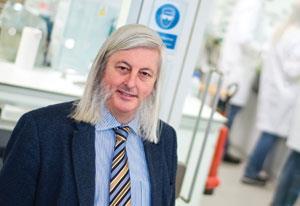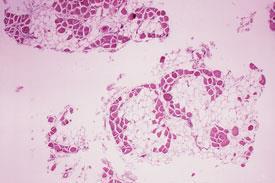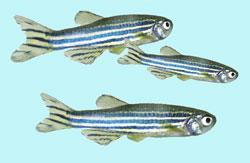Steve Davies has made successful business his hobby. He reveals some of the secrets of entrepreneurial chemistry to Sarah Houlton
Steve Davies has made successful business his hobby. He reveals some of the secrets of entrepreneurial chemistry to Sarah Houlton
A frustration with the tail-chasing process of grant applications led Steve Davies into the entrepreneurial world of spin-out companies. ’Back in the late 1980s, I sat back and looked at what I was doing, and about 60 per cent of my time was spent applying for money, probably 25 per cent teaching, and the remaining 15 per cent was taken up by admin,’ he says. ’What fun is that? I knew that the chemistry we were developing at the time was commercially valuable. Normally, people would just publish their work and let someone else take the value, but I thought - why don’t I set up a company to exploit this?’ And with that big decision, his first company, Oxford Asymmetry, was born.

Davies has spent most of his career in Oxford, having started as an undergraduate there in 1969, staying on for a DPhil with Gordon Whitham in organic chemistry, and then securing an ICI fellowship to work with Malcolm Green, learning about organometallic chemistry. After sampling life in Paris - first on a Nato fellowship in Derek Barton’s group in Gif-sur-Yvette, and then moving to a permanent position at the French National scientific research centre (CNRS) working closely with Hugh Felkin - in 1980 he was invited back to Oxford as a lecturer. And he remains there now, as Waynflete professor of chemistry and chairman of the department.
His career has been underpinned by the discovery of new methodologies and then finding applications for them. ’We’ll tackle anything involving synthesis and stereochemistry,’ he says. ’We don’t care if we use enzymes, transition metals or whatever, as long as it’s synthesis - whatever takes our fancy and whatever we think we can make a real impact on.’
It was this focus on useful methodology that led to Oxford Asymmetry being set up in 1992. ’It was a lot of work at the start to establish it and ensure it ran well,’ he says. ’At first, [it was] three people out of my group working in a small lab in Oxford and then, with the help of two business angels, the company grew.’ It moved into new premises on the Milton Science Park near Abingdon, and the angels helped to find a chief executive and the rest of the management team. ’I’m a scientist - I want to do chemistry, not run companies myself,’ says Davies.
The company was set up with an initial capital of just ?100,000 - partly raised by Davies remortgaging his home. The intention was to grow the company organically rather than go out looking for big outside investments. ’I have a morbid fear of venture capitalists,’ he says. ’I’ve never taken on any VC money and I never intend to - I think they take much of the value out of the company and the people who had all the ideas don’t realise as much as they should.’
As the name suggests, Oxford Asymmetry originally specialised in asymmetric synthesis; unusually for that time, it was a pure chemistry service company making molecules on a contract basis, rather than also being involved in drug discovery. This meant it didn’t compete with its customers’ businesses in any way. ’We went to potential customers and said to them, "give us all the molecules that you’ve employed other companies to make and they’ve failed. If we don’t succeed, you don’t pay us." We made every single one of them, and this established the reputation of the company.’ This all happened in the first year, and meant the business was instantly sustainable, with more staff being taken on in response to additional contracts rather than on spec.
Combining companies
Just three years later, Davies spotted another opportunity. ’At the time, there were a number of combinatorial chemistry companies, mostly in the US, and big pharma companies were buying them up at a rate of knots,’ he says. In a discussion with Davies, one pharmaceutical firm said that it was unable to find a suitable company to buy. ’So I said we’d set up a company to supply all their libraries instead. I set up Oxford Diversity for virtually no money, as this big deal was already in the bag.’

The result was what he describes as a very efficient combichem company, which made huge libraries of single compounds. This was unusual - at the time, the vogue was to make mixtures of very many different compounds and deconvolute them back to whichever compound (or compounds) might be active. ’I took a view that eventually people would realise that that’s not a very sensible approach, and they would want single compound libraries,’ he says. ’If people wanted mixtures, we’d simply mix the single compounds.
’As we grew Oxford Diversity, the mixtures came down from millions of compounds to thousands, to hundreds, to tens, and then to one. So we were providing a service before people knew they wanted it, which everyone else quickly moved towards.’
The synthesis company and the combichem company were combined into one entity, Oxford Asymmetry International (OAI), in 1999. By that stage the company had been floated on the London Stock Exchange, a pilot plant had been built and the business had evolved into a fully fledged service company that could do synthesis on any scale, from very small libraries through the drug discovery scale right through to the pilot plant. ’We were doubling in size every year, and while this organic growth was fantastic, it ultimately would be unsustainable.’ There were three possibilities, Davies says: ’take over another company to help us sustain growth; merge with another company; or sell the business. And we did something between a merger and a sale to the German company Evotec in 2000.’ In just eight years, the company had grown from a ?100,000 initial investment - with Davies’ own house on the line - to the ?316m it was sold for.
And by this point, Davies employed 250 chemists - having started with a team of just three. He considers it one of his biggest achievements that for almost four years he was the largest employer of new PhD chemists in the UK. ’The pharma industry was on a downturn, and there were few jobs available, except in my company,’ he says. ’We kept a lot of chemists in chemistry over that period. Some are still with Evotec, and some have moved on, but at least they are still in chemistry.’
Testing on the small scale
Another reason why selling OAI was attractive to Steve was that he had an idea for yet another project - a service and drug discovery chemical genomics company. And in 2003, VASTox - Value Added Screening Technology Oxford - was born, with the aim of using zebrafish in drug discovery - rather than rodent or other animal testing. ’The US National Institutes of Health has said that zebrafish are the third closest animal in terms of the genome to humans,’ he says. ’And they’re tiny. Every time you turn the light on, they breed. In nature, the fish eat their own embryos - it’s their form of birth control - so we collect the eggs before they are eaten, and can use them to look for novel drug compounds and toxicity testing.’

As well as offering zebrafish testing services, the new company also set up a drug discovery programme using the technology. Davies had already set up several of these in his lab, and they are now part of the company. ’We have one looking for small molecules to treat Duchenne muscular dystrophy,’ he says. ’This terrible disease only affects about 30,000 patients around the world and is a spontaneous mutation, so the patient population is never going to disappear. Kids with Duchenne are in wheelchairs by the age of eight or nine, and they usually die in their early 20s. But it’s not a common enough disease for big pharma to be interested because the potential revenue is too low.’
The bodies of those with the disease fail to make the protein that binds muscle fibres together - so the muscles, essentially, fall apart. It isn’t detected for the first couple of years, because in the foetal state there are two different processes that produce these proteins. After birth, one of these processes is turned off automatically, and Duchenne’s results if there’s a problem with the other. Davies’s idea was to look for a small molecule that would turn the switched-off mechanism back on. ’We’ve proved that it’s possible and it’s a druggable target,’ he says. ’We’ve now got compounds advancing through the drug discovery process, and one in the late preclinical stages, so we hope to start Phase I clinical trials soon.’ The company is also looking at several other drug targets where the patient population is too small to be interesting to big pharma companies.
The company floated on AIM (Alternative Investment market) - the London Stock Exchange’s international market for smaller, growing companies - in 2004. It has grown rapidly by making acquisitions. ’We bought Daniolabs, the other UK zebrafish company, last year, and I think that now makes us the largest zebrafish company in the world,’ he says. ’We also use carbohydrates for drug discovery. We acquired Dextra in Reading last year and now we’re one of the largest specialist carbohydrate companies in the world, too. We also bought the assets of MNL Pharma [a UK drug discovery company which went into administration in October 2006], from the official receiver, as it has large libraries of untested natural products that we can use in our drug discovery process.’

After making these acquisitions, the company’s name was changed to Summit, as VASTox only applied to one part of the business, and Davies stepped back from his role as chairman in 2007, remaining a non-executive director. ’The whole philosophy of setting up companies is not for me to run them myself,’ he says. ’I don’t think it ever works if an academic sets up a company and tries to run it alongside an academic role. I put in the best management team and scientists I can find, and leave them to get on with it. I always try to help, of course, but if you put the right team in you have a much better chance of success.’
As hobbies go, Davies says, setting up companies has been fantastically interesting and rewarding. ’I must have enjoyed the first two to want to do it again,’ he says. ’And there have been two more since VASTox. One, called oXray, focuses on the control of crystal growth and crystal structure determination, and the other, Sci-Ink, is a not-for-profit publishing company that produces textbooks for students. We sell these at ?5, which is the cost as subsidised by AstraZeneca and Sigma-Aldrich. It’s the price of a couple of beers, not the price of 20 beers.’
Oxford University has a stake in most of the companies; it has always taken the view that it owns the intellectual property for anything that is generated within the university, and Davies fully supports this. ’It’s a very clean-cut way of organising things. [The university] has very particular rules about how equity can be split if IP is involved, with everything clearly laid out in everyone’s contract.’ When Oxford Asymmetry was set up, the university gave 15 per cent of its proceeds back to the chemistry department, and this continued through the other companies. It has recently increased this to 25 per cent. ’This helps us establish new chairs and put in infrastructure that we otherwise couldn’t raise the money for, like our new building which cost ?65m, which I believe is the best building in the world for doing organic chemistry.
’We raised all the money ourselves; some from government and companies, and the remaining ?20 million came from IP Group, which it gave us in exchange for 50 per cent of the university’s equity stake in any spin-out company for the next 15 years. It was a great deal for everyone; 14 companies have been formed since the deal was done in 2000, and all of them are still in business. If you look at their market capitalisation or the price they were sold for, chemistry alone has generated ?1.8 billion of wealth from its spinouts. I think that’s very impressive.’
And his initial aim of finding an easier way to fund his research has been a resounding success. ’Part of my research is still funded by the money from Oxford Asymmetry,’ he says. ’I do still need to write grant application proposals, but it’s now more of a choice than a necessity - and if I see an area where there’s a real opportunity, now I can do some basic work in advance to make the proposal stronger. It allows me to do what I really want to do - have fun doing organic chemistry. Chemistry is coming back to the fore as the essential science that enables all other things, and we should be out there grasping the opportunities.’
Sarah Houlton is a freelance science journalist based in London, UK.






No comments yet